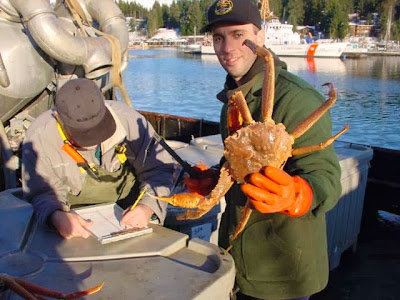Tanner crab, AMCC
Snow crab, AFSC
RAMP measures for crab mortality have been validated and used in field experiments to help reduce the effects of trawl gear encounters by crabs. Hammond et al. 2013 published the results of a study on Tanner and snow crab mortality associated with trawl gear encounters and they are quoted below:
“The study used the RAMP model to investigate whether modifications to the bottom trawl gear, specifically sweeps (cables connecting doors to trawlnet) and footrope (ground-contact gear attached to the trawlnet), reduced the unobserved mortality of snow and Tanner crab. The RAMP models for these species from Stoner et al. (2008) were augmented with additional observations that more than tripled the sample sizes. Alternative configurations of the resulting RAMP models were compared, examining the effects of sex, size, and shell condition, supplementing with injury observations, and application as a categorical or continuous variable. RAMP-estimated mortality rates were then applied to determine if alternative fishing gear reduced unobserved mortality compared with conventional fishing gear. Specifically, mortality rates for raised trawl sweeps (Rose et al., 2010) and larger diameter footropes were compared with rates for conventional configurations (Rose et al., 2013). Both modifications create larger spaces under the gear for crab escapes. These mortality rates were also compared across sex, size, and shell conditions.”
Reflex actions that were tested for RAMP:
“A major advantage to RAMP is the simplicity of just testing reflexes which can be done in hand, thereby removing the need to retain animals for prolonged periods or to run costly and time consuming physiological lab tests. In the case of Chionoecetes spp. interacting with the trawl gear, Stoner et al. (2008) and this study have shown the reflex impairment score to be a statistically robust predictor of delayed mortality. The effect of a single additional reflex impairment multiplies the odds of mortality (p/(1- p)) by the exponentiated slope from the logistic regression (Faraway, 2006). The multipliers for snow and Tanner crab were 3.0 and 2.9, respectively. Thus, the absence of an additional reflex would roughly triple a crab’s odds of mortality.”
RAMP curves for Tanner and snow crabs:
“Logistic regression analysis of reflexes to predict mortality (RAMP model) indicated that sex, shell condition, and size did not significantly affect the relationship between reflex impairment scores and mortality. When considering the effect of the gear type, logistic regression of the RAMP-predicted mortality found that gear type, sex, shell condition, size, and the gear × shell condition interaction were significant predictor variables for snow crab mortality. Tanner crab showed gear type, shell condition, and their interaction to be significant with the footrope effect. In addition, gear type, shell condition, their interaction, and size were significant with the effect of sweeps. Although shell condition was shown to be statistically significant, the overall mortality was lower with an alternative gear than with a conventional gear, strengthening the case that alternative sweeps and footropes could be used to help reduce unobserved mortality.”
Experimental trawl gear used in study:
Results of gear modification on crab mortality:
“Previous studies have shown that reflex impairment is a sign of stress that can be correlated with mortality outcomes in fish and crab (Davis and Ottmar, 2006; Davis, 2007, 2009; Stoner et al., 2008; Humborstad et al., 2009; Stoner, 2009). One of the limitations of this approach is that we cannot account for the possible mortality that occurs as a result of predation on the crab or fish due to its potentially weakened state from its encounters with the gear. Thus, the RAMP model yields a good relative measure of mortality, if not an absolute measure of mortality. Our study took the RAMP model one step further and used it to assess whether alternative sweeps and footropes could reduce unobserved fishing mortality; the data showed this to be the case.”
“This study is one example of many possible practical applications of the RAMP model. In the context of bycatch reduction technology and modified fishing gear, the RAMP model could prove to be a very useful tool to determine if the alternative gear or modifications to the current fishing gear could reduce the many types of bycatch mortality.”






